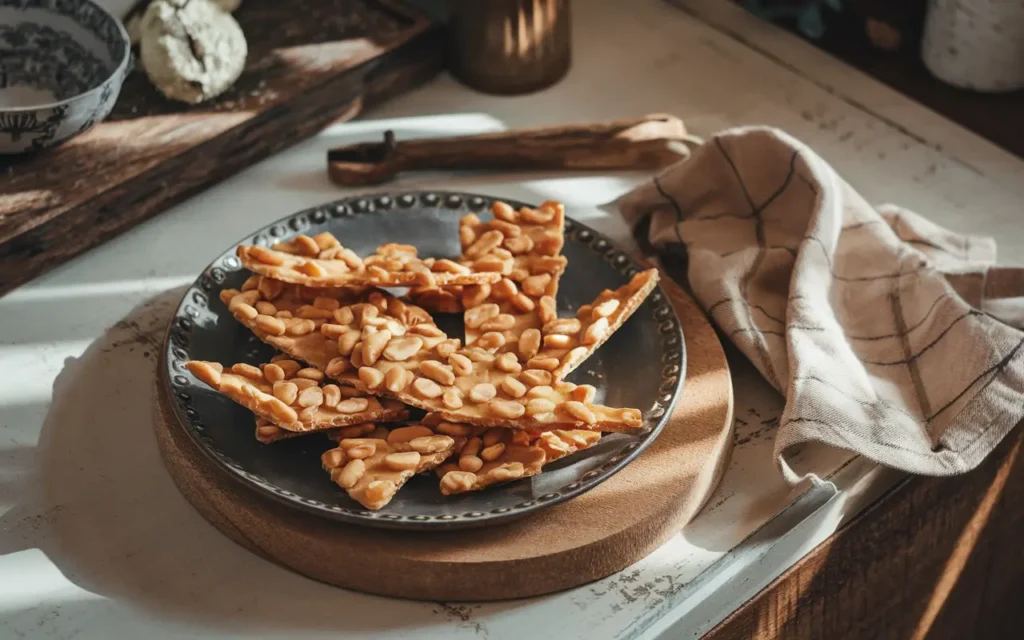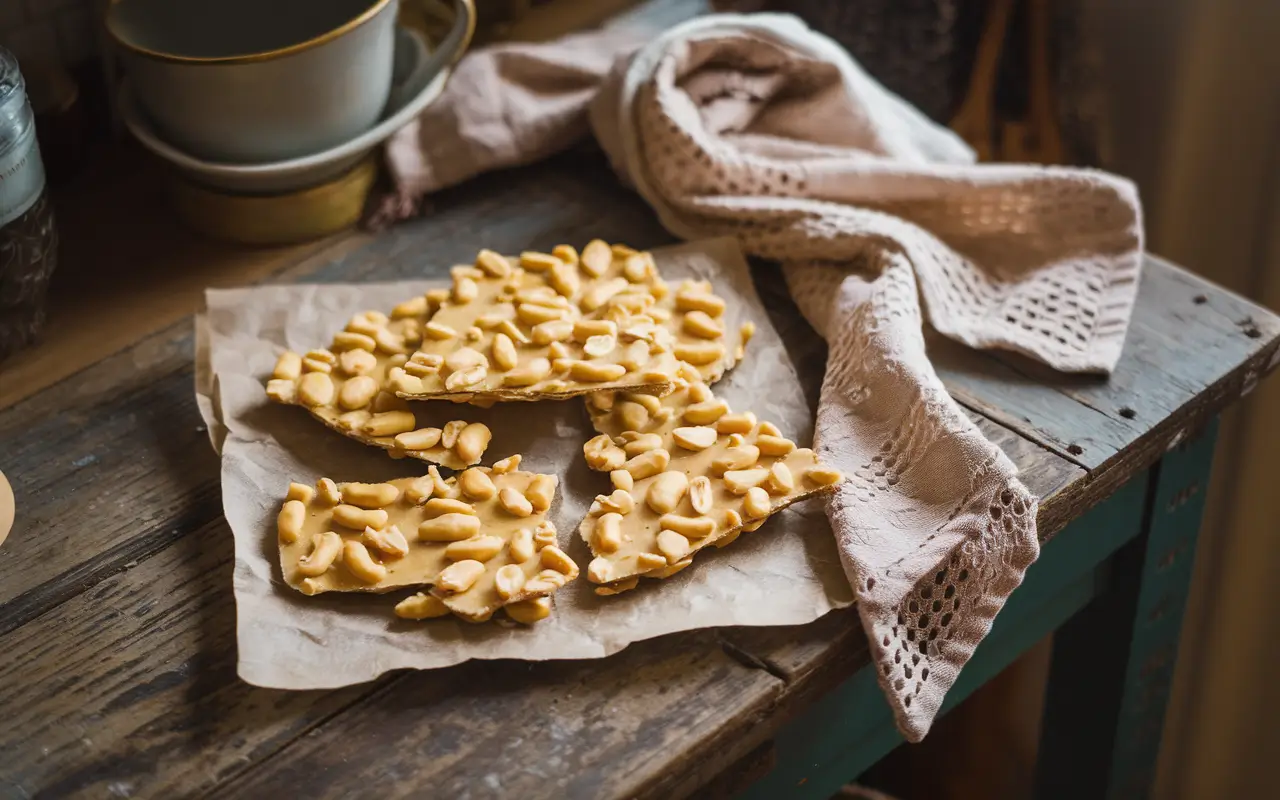Peanut brittle, a sweet, crunchy delight, has been a beloved treat for generations. From its fascinating origins to modern-day kitchen tips, this guide is your go-to resource for everything about peanut brittle. We’ll explore its history, the science behind its irresistible texture, and how you can make this classic dessert at home. Plus, we’ll dive into creative variations, storage tips, and frequently asked questions to ensure your peanut brittle always turns out perfect.
Table of contents
- Introduction to Peanut Brittle
- The Science Behind Peanut Brittle
- How to Make Peanut Brittle at Home
- Variations of Peanut Brittle
- Health and Nutrition Facts
- How to Store and Serve Peanut Brittle
- Frequently Asked Questions About Peanut Brittle
- Fun Facts and Trivia About Peanut Brittle
- Conclusion and Final Thoughts
Introduction to Peanut Brittle
What is Peanut Brittle?
Peanut brittle is a hard candy made by caramelizing sugar and blending it with peanuts. As the mixture cools, it hardens into a golden sheet of crunchy goodness. This classic confection boasts a sweet, nutty flavor that’s as timeless as it is delicious. Loved by candy enthusiasts worldwide, is the perfect combination of sweetness and texture, with peanuts adding a rich, nutty crunch to every bite.
The versatility of also makes it stand out. Whether enjoyed as a homemade treat, given as a holiday gift, or purchased from gourmet candy shops, this dessert consistently delivers nostalgia and joy.
A Brief History of Peanut Brittle
The origins of peanut brittle are shrouded in mystery, but several stories point to its deep roots in Southern American cuisine. Legend has it that was accidentally invented when a cook added baking soda to a boiling sugar mixture instead of cream of tartar. This happy mistake led to the creation of the light, airy texture we associate with brittle today.
Historically, peanuts became a popular ingredient during the 19th century, thanks to their affordability and availability in the Southern United States. Combining peanuts with caramelized sugar became a natural evolution, resulting in the iconic dessert we love. Over time gained global popularity, with countries adding their own spins on the classic recipe.
Whether you’re a long-time fan or new to the world of brittle, this guide will inspire you to appreciate and even create this delightful confection. Stay tuned for tips, tricks, and creative takes on this cherished treat.
The Science Behind Peanut Brittle
How Sugar Caramelization Works in Peanut Brittle
The secret to peanut brittle’s delectable texture lies in the process of sugar caramelization. When sugar is heated, its molecules break down, creating a golden-brown color and a complex flavor profile that includes sweet, nutty, and slightly bitter notes. sugar is usually combined with water, butter, or corn syrup to prevent crystallization and ensure a smooth, glossy finish.
As the mixture heats, it reaches the critical “hard crack” stage, where the sugar syrup hardens into a brittle texture once cooled. This stage typically occurs between 300–310°F (149–154°C). Adding baking soda at the right moment introduces air bubbles, giving its characteristic light, airy structure.
Understanding these chemical reactions helps you troubleshoot common issues, like sticky or overly hard brittle. With the right technique, you can master the perfect candy every time.
Why Peanuts Are Ideal for Brittle
Peanuts are the star ingredient in this classic candy for good reason. Their natural oils and crunch complement the brittle’s caramelized sugar base perfectly. Additionally, peanuts are affordable, widely available, and rich in protein and nutrients, making them an ideal addition.
Another advantage of peanuts is their ability to hold up well under high temperatures. Unlike some nuts that can scorch during cooking, peanuts maintain their flavor and texture, ensuring a delicious crunch in every bite. This versatility makes them a staple in many variations of brittle worldwide.
For more tips on achieving the perfect texture in confections, check out this guide to caramel shortbreads, which shares similar sugar-handling techniques.
How to Make Peanut Brittle at Home
Essential Ingredients and Tools
To make peanut brittle, you need just a handful of simple ingredients: sugar, water, corn syrup, butter, baking soda, and, of course, peanuts. These pantry staples come together to create a candy that’s both satisfying and timeless.
For tools, you’ll need a candy thermometer, a large saucepan, and a flat baking sheet. A silicone spatula and parchment paper can also make the process easier and less messy.
Step-by-Step Peanut Brittle Recipe
- Prepare Your Workspace
Line a baking sheet with parchment paper or grease it lightly with butter. Gather all your ingredients in advance since timing is crucial in candy-making. - Cook the Sugar Mixture
Combine sugar, water, and corn syrup in a saucepan over medium heat. Stir until the sugar dissolves completely, then stop stirring to prevent crystallization. - Monitor Temperature
Using a candy thermometer, cook the mixture until it reaches 300°F (hard crack stage). Remove it from heat immediately to avoid burning. - Add Butter and Baking Soda
Stir in butter, baking soda, and peanuts quickly. The mixture will foam due to the baking soda, creating air pockets that lighten the candy. - Spread and Cool
Pour the mixture onto your prepared baking sheet and spread it out with a spatula. Let it cool completely before breaking it into pieces.
Common Mistakes to Avoid When Making Peanut Brittle
- Skipping the Candy Thermometer: Eyeballing the temperature often leads to undercooked or burnt candy.
- Stirring Too Much: Over-stirring can encourage sugar crystallization, making the brittle grainy.
- Rushing the Cooling Process: Letting the brittle cool naturally ensures the right texture and prevents cracking.
For a different twist on homemade candy, consider exploring recipes like candy cane fudge for festive inspiration.
Variations of Peanut Brittle
Creative Additions: Chocolate, Spices, and More
While traditional peanut brittle is undeniably delicious, adding unique flavors can elevate this classic treat to new heights. Chocolate is a popular addition, whether drizzled on top or mixed into the brittle for a double dose of indulgence. You can also sprinkle sea salt over the cooled brittle for a sweet-and-salty twist.
Spices like cinnamon, nutmeg, or even cayenne pepper bring a warm, aromatic element to the candy. For those who enjoy texture, mix-ins like shredded coconut, pretzel bits, or other nuts—almonds, cashews, or pecans—add variety and crunch.
Experimenting with flavors not only personalizes your peanut brittle but also makes it a fun option for themed gifts or holiday treats. These creative spins are easy to achieve and will impress even the most seasoned candy enthusiasts.
International Takes on Peanut Brittle
Different cultures have put their own spin on nut-based brittles. In India, for instance, “chikki” is a popular dessert made with jaggery and peanuts, offering a slightly softer texture and a rich, molasses-like flavor. Meanwhile, Middle Eastern brittle recipes often incorporate pistachios and cardamom for a fragrant, luxurious treat.
Exploring these variations can inspire you to try new ingredients and techniques in your own kitchen. They show just how versatile peanut brittle can be, adapting to diverse flavor profiles while retaining its signature crunch.
For more inspiration on desserts with global appeal, check out this recipe for French apple pie, a classic treat with international flair.
Health and Nutrition Facts
Caloric Breakdown of Peanut Brittle
Peanut brittle, while a delightful indulgence, is undeniably rich in calories and sugar. A single serving (about 1 ounce) typically contains around 150–200 calories, depending on the recipe. This includes carbohydrates from the sugar, fats from the peanuts, and a small amount of protein.
Despite its calorie-dense nature, peanut brittle does provide some nutritional benefits. Peanuts are a good source of healthy fats, protein, and essential vitamins like niacin and vitamin E. They also contain minerals like magnesium and phosphorus, which support bone health.
Is Peanut Brittle Healthy?
While peanut brittle isn’t considered a health food, it can still be enjoyed in moderation as part of a balanced diet. To make it slightly healthier, consider substituting traditional sugar with alternatives like coconut sugar or using unsalted peanuts to reduce sodium.
For those with dietary restrictions, homemade recipes allow for greater control over ingredients. Vegan versions can be made using plant-based butter, and gluten-free adaptations are naturally easy since the core ingredients are free of wheat.
If you’re looking for other treats that balance indulgence with nutrition, you might enjoy this recipe for soft, chewy sugar cookies, which pairs well with lighter meals or desserts.
How to Store and Serve Peanut Brittle

Best Practices for Storing Peanut Brittle
To keep your peanut brittle fresh and crunchy, proper storage is essential. Once the brittle has cooled completely, break it into pieces and store it in an airtight container. This prevents moisture from seeping in, which can make the candy sticky and ruin its signature crunch.
For long-term storage, place the airtight container in a cool, dry place away from direct sunlight. can stay fresh for up to two months if stored correctly. If you live in a humid area, consider adding a small silica gel packet or a piece of parchment paper to absorb excess moisture.
Creative Ways to Serve Peanut Brittle
Peanut brittle isn’t just a standalone treat—it can also shine as part of other desserts. Crush it into small bits and use it as a topping for ice cream, yogurt, or even cakes. It adds a satisfying crunch to dessert platters when paired with softer treats like brownies or mousse.
For a festive touch, wrap pieces of peanut brittle in decorative cellophane or place them in tins for gifting during the holidays. Its versatility makes it an ideal choice for parties, snacks, or thoughtful homemade gifts.
Frequently Asked Questions About Peanut Brittle
What is the Shelf Life of Peanut Brittle?
Peanut brittle has an impressive shelf life when stored properly. In an airtight container kept at room temperature, it can last for up to two months without losing its crunch. Avoid refrigeration, as the moisture in the fridge can make the brittle sticky and less enjoyable.
Why Did My Peanut Brittle Turn Out Sticky?
Sticky peanut brittle is often the result of not cooking the sugar mixture to the correct temperature. Reaching the hard crack stage (300–310°F) is crucial for creating the brittle’s crisp texture. Humidity can also cause stickiness, so try making brittle on a dry day for the best results.
Can I Use Other Nuts Besides Peanuts?
Absolutely! While peanuts are traditional, you can easily substitute almonds, cashews, or pecans for a unique twist. Each nut offers a distinct flavor and texture, allowing you to customize your brittle to suit your taste.
For more tips and ideas, explore other classic recipes like our guide to brownie cookies, which pairs wonderfully with crunchy desserts like brittle.
Fun Facts and Trivia About Peanut Brittle
The Origins of the Name
Did you know the term peanut brittle perfectly describes its nature? The word “brittle” refers to the candy’s texture—hard yet delicate, breaking easily into pieces when snapped. This name has become synonymous with the treat, making it instantly recognizable around the world.
Record-Breaking Peanut Brittle
Peanut brittle has made its mark in the Guinness World Records. One of the most famous attempts occurred in 2012, when a group in Oklahoma created the largest peanut brittle, weighing over 21,000 pounds! This impressive feat highlighted not only the love for this classic candy but also its cultural significance.
A Holiday Staple
While peanut brittle can be enjoyed year-round, it’s especially popular during the holiday season. Its long shelf life and crowd-pleasing taste make it a go-to gift for Christmas, Hanukkah, and other festive occasions. Many families even have their own cherished recipes, passed down through generations.
Conclusion and Final Thoughts
Peanut brittle is more than just a sweet treat—it’s a delightful combination of history, science, and tradition. From its humble beginnings to becoming a global favorite, this candy has stood the test of time, offering a satisfying crunch and rich flavor that’s hard to beat.
Whether you stick to the classic recipe or get adventurous with creative twists like chocolate or exotic spices, is a versatile dessert that fits any occasion. Its straightforward preparation process makes it accessible to both seasoned chefs and kitchen novices.
For those who appreciate homemade delights, peanut brittle is a reminder of the joy that simple ingredients can bring. With just a bit of patience and the right technique, you can master this timeless candy and share it with loved ones.
If you’re inspired to explore more desserts, check out our Texas sheet cake guide for another classic recipe that’s perfect for sharing.

